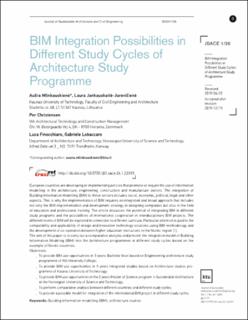| dc.contributor.author | Mlinkauskiene, Ausra | |
| dc.contributor.author | Jankauskaite-Jureviciene, Laura | |
| dc.contributor.author | Christensen, Per | |
| dc.contributor.author | Finocchiaro, Luca | |
| dc.contributor.author | Lobaccaro, Gabriele | |
| dc.date.accessioned | 2022-05-11T06:12:54Z | |
| dc.date.available | 2022-05-11T06:12:54Z | |
| dc.date.created | 2020-05-14T15:26:46Z | |
| dc.date.issued | 2020 | |
| dc.identifier.citation | Journal of sustainable architecture and civil engineering.. 2020, 26 (1), 5-17. | en_US |
| dc.identifier.issn | 2029-9990 | |
| dc.identifier.uri | https://hdl.handle.net/11250/2995145 | |
| dc.description.abstract | European countries are developing or implementing policies that promote or require the use of information modelling in the architecture, engineering, construction and manufacture sectors. The integration of Building Information Modelling (BIM) to these sectors includes social, economic, political, legal and other aspects. This is why the implementation of BIM requires an integrated and broad approach that includes not only the BIM implementation and development strategy in designing companies but also in the field of education and professional training. The article discusses the potential of integrating BIM in different study programs and the possibilities of international cooperation in interdisciplinary BIM projects. The different levels of BIM will be explored in connection to different curricula. Particular attention is paid to the compatibility and applicability of design and innovative technology solutions using BIM methodology and the development of co-operation between higher education institutions in the Nordic region [1].
The aim of this paper is to carry out a comparative analysis and present the integration model of Building Information Modeling (BIM) into the Architecture programmes in different study cycles based on the example of Nordic countries.
Objectives:
To provide BIM use opportunities in 3 years Bachelor level based on Engineeering architecture study programme of VIA University College;
To provide BIM use opportunities in 5 years Integrated studies based on Architecture studies programme of Kaunas University of Technology;
To provide BIM use opportunities in the 2 years Master of Science program in Sustainable Architecture at the Norwegian University of Science and Technology;
To perform comparative analysis between different countries and different study cycles;
To provide a possible model for integration of the international BIM project in different study cycles. | en_US |
| dc.language.iso | eng | en_US |
| dc.publisher | Kaunas University of Technology | en_US |
| dc.rights | Navngivelse 4.0 Internasjonal | * |
| dc.rights.uri | http://creativecommons.org/licenses/by/4.0/deed.no | * |
| dc.title | BIM integration possibilities in different study cycles of architecture study programme | en_US |
| dc.title.alternative | BIM integration possibilities in different study cycles of architecture study programme | en_US |
| dc.type | Peer reviewed | en_US |
| dc.type | Journal article | en_US |
| dc.description.version | publishedVersion | en_US |
| dc.source.pagenumber | 5-17 | en_US |
| dc.source.volume | 26 | en_US |
| dc.source.journal | Journal of sustainable architecture and civil engineering. | en_US |
| dc.source.issue | 1 | en_US |
| dc.identifier.doi | 10.5755/j01.sace.26.1.22393 | |
| dc.identifier.cristin | 1811081 | |
| cristin.ispublished | true | |
| cristin.fulltext | original | |
| cristin.qualitycode | 1 | |

